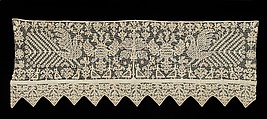Bed curtain border
Not on view
This object is from the collection of Natalia de Shabelsky (1841-1905), a Russian noblewoman compelled to preserve what she perceived as the vanishing folk art traditions of her native country. Traveling extensively throughout Great Russia, she collected many fine examples of textile art of the wealthy peasant class. From the 1870s until moving to France in 1902, Shabelsky amassed a large collection of intricately embroidered hand-woven household textiles and opulent festival garments with rich decoration and elaborate motifs. The Brooklyn Museum holdings include many fine examples including the majority of the garments. Portions of Shabelsky's collection are also housed at the Museum of Fine Arts, Boston, the Cleveland Art Museum, and the Russian Museum of Ethnography in St. Petersburg.
Depictions of the goddess are common in Russian embroidery, traditionally associated with fertility. Later depictions of the goddess are very stylized, resembling a plant or tree-of life, as in this example. A smaller daughter or minor goddess often accompanies the great goddess in embroideries intended to represent reproductive fertility. The double-headed Imperial eagle is common to many cultures throughout history, most notably the Byzantium. Through Ivan III's marriage to Zoe Palaeologina, niece of Byzantine emperor Constantine XI, the heraldic symbol spread to Russia. The dual heads were meant represent the secular and religious sovereignty of the monarch, as well as sovereignty over the East and West.
This image cannot be enlarged, viewed at full screen, or downloaded.
This artwork is meant to be viewed from right to left. Scroll left to view more.



